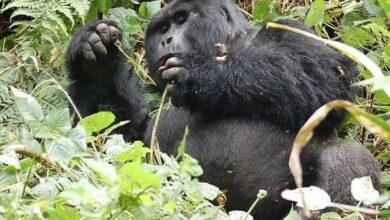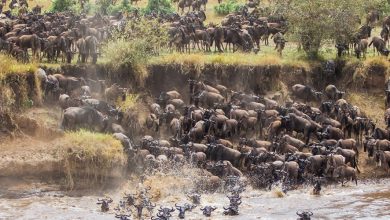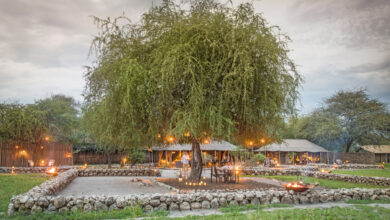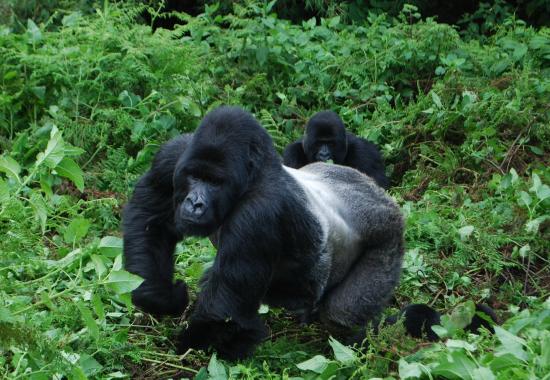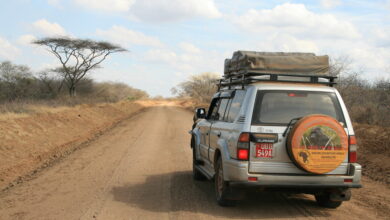Blog
Migration Safari and Gorilla Trek, Tanzania & Uganda
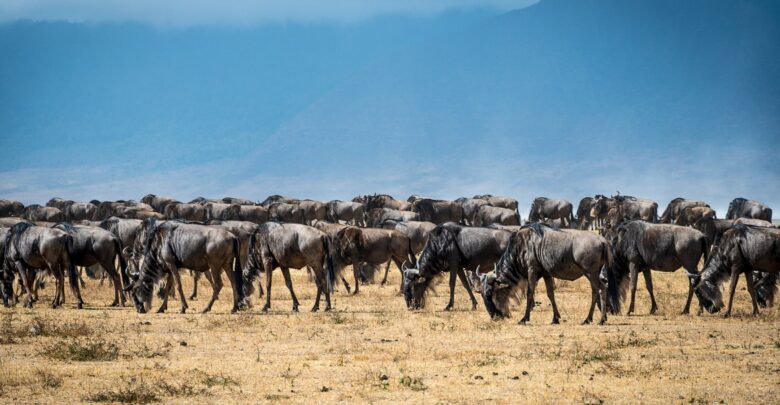
The great wildebeest migration safaris in Tanzania and Kenya are becoming the most famous expedition that one shouldn’t miss while on an African safari in East Africa. Thereafter, enjoying this migration experience, you can combine it with gorilla trekking in Uganda or Rwanda and it is among the highlights of the adventures.
Therefore, with our Africa travel experts we can tailor you the amazing Tanzania Uganda Safari staying at the luxury Sanctuary Retreats and also, we can offer you the whole year Lemala Camps Safari in Tanzania and Uganda and offering the wildebeest and mountain gorillas.
Watching the wildebeests matching and crossing over from the plain of Serengeti to Masai Mara is a called an annual wild dramatic moment. These thousands of creatures, gather to form the ever-largest herds of thousands wandering through the golden Savannah.
The two parks that accommodate the largest population of wildebeest share the borders of Africa’s prominent safari Parks. Maasai Mara game reserve in Kenya and Serengeti National Park in Tanzania are both world classic adventure peaks. There is no any other adventure in the golden Savannah plains can offer such a dramatic moment that watching these thousands of wildebeest creatures passing.
On the same demand gorillas as started earlier are global adventure profits. Just know they are very limited for sight, due to their limited number. Mountain gorilla trekking in Uganda is highlight for the rest of the adventures in Africa. In Uganda gorilla trekking is special and unique as it’s open to all travelers with all budgets of traveling.
Gorilla trekking means entering into the deep of the forests of either Bwindi Impenetrable National Park, or Virunga forests and launch a search for apes. The search may last for some good times but with the highest probability of surety to encounter them. Gorilla trekking is an adventure which can’t just be found anywhere accept, Uganda, Rwanda and Democratic Republic of Congo.
Migration Safaris in Tanzania
The greatest Migration safari talked about in the world, consist of millions of animals of wildebeest, zebras, and gazelle making a clockwise wander across the Savannah plains of Serengeti and Masai Mara.
The journey starts with a birth of half a million calves of south of Serengeti and the movement proceeds to Masai Mara. This is annual life circle of the wild is can’t be encountered elsewhere in the world. Approximately about 2 million animals dominated with wildebeests do migrate.
Migration Period
At the southern section of the Serengeti, wildebeest give birth to calves and hundreds of predators (lions, leopards, hyenas) are hunting for these fresh prey. When drought approaches, in the month of May, then the migrators wander from the southern plains and ascend northwards to Masai Mara in Kenya. Through the Serengeti Mara corridor, these animals keep on grazing the green grass alongside hundreds of gazelle and zebras.
These animals occupy the northern corridor from July until short rain begins in October where the migration return slowly to Serengeti. By December, the herds trek past Seronera settlement of central Serengeti which is the official visitor’s center for Serengeti is located. December to March the migration happens between Ngorongoro and Serengeti plains, it’s a bit raining the vegetation is green and waters insinuate stay.
The migration drama happens mainly during July when migrators face the first crossing obstacle. The River Grumeti crossing makes some of the animal not to survive the terror as the river consist of crocodile which devour some, and the predators treat them as a pond of their prey.
The wildebeest migration drive
Watching the wildebeests together with larger herds of gazelles and zebras crossing the plain of Serengeti. The adventure being a spectacular wild encounter has attracted thousands of travelers across the world who wish to pleasure for a dramatic adventure.
Gorilla Trekking in Uganda
The gorilla trekking safari is the highlight of the rest of the adventures in Africa. Uganda in this aspect has statured to propose the best gorilla trekking experiences. There are more opportunities to watch gorillas than in any other gorilla destination.
Gorilla trekking adventure can be an independent safari or a combined safari. And doing an East African adventure safari that combines both gorilla trekking and the annual dramatic wildebeest migration means the African best safari offer.
Uganda boasts for being the only country that host two gorilla forests (habitants). Gorillas in Uganda are trekked from either Bwindi Impenetrable Forest National Park or Mgahinga Gorilla National Park.
Bwindi Impenetrable Forest National Park as well scooped the position of hosting the highest number of gorillas in the wild. About half of the world’s remaining mountain gorillas call Bwindi their home.
Gorilla trekking to some extent means tracing human origin which is dated 40 million years ago according to scientist researchers. A simple background indicate that the gorillas are the largest among the primate species. And the mountain gorillas have stood to be the most exciting creatures to watch.
However, the mountain gorillas are very limited in number with about 1063 gorillas in the wild according to very recent gorilla census 2019. There are several gorilla births registered with the minimum of about 5 gorilla each year.
Mountain gorillas are endangered species according to the IUNC, the species are registered on the red list of endangered species. And as well are endemic to the two zone is Bwindi Impenetrable Forest and Virunga Massif.
By 1980s gorilla faced the hectic threat of extinction, with about only 300 gorillas had sustained in the wild. This forced the governments to resort on conservation effort with a forced expulsion people from the forests to create an environment for conservation. Then gorilla trekking came in here as one way of conservation in form of sustainable tourism.
How is gorilla trekking?
Gorilla trekking is a call for aptness, not only for the carnal erect, but at least a certain level of fitness should be. The trek is about rolling into the impenetrable tropics that features valleys, hills, slopes and hikes. It starts as a search for the gorillas where trekkers have to find their own path through the impassable muddy, thorny, and scrabbling grounds. There is no specific time to spend on the trek, but the period depends on the distance at which you assigned habituated gorilla family has wandered.
Gorilla trekking can last for about 30 minutes to 5 hours searching for your assigned gorilla family. The walk is guided by an experienced and armed ranger guide, along the walk you keep following the fresh foliage breaks, dungs and sounds until when you reach your trekked family.
Upon finding your trekked assigned it’s in most cases a long trek and finding. At this moment most of the trekkers are exhausted, it’s the most amazing time in the jungle. You have an hour in the midst of the gorilla, watching the toddler jumping into tree branches. Watching the silver back charging or lousily relaxed. This is a lifetime moment taking memories with silent and un-flashing cameras.
When is the Best Time to Trek Gorillas in Uganda
Gorilla trekking can be experienced and done throughout the year. However, the best time of wandering on hikes and slopes within the impenetrable forests searching for the species remains for the dry seasons.
The dry seasons happens in the month of December to February, and from June to September. These are peak traveling months; the weather is characterized with low rainfall reception. The trekking ground are often dry and low expectation of rainfall during the trekking hours.
The wet season as well stands also possible to trek, however, during the months of March to May, and September to November experience a lot of rainfall. The trekking forests are always wet, muddy and slippery. Trekking during these months it’s hectic and very challenging.
The Great Migration and gorilla safari experience in Tanzania and Uganda. There are several arrangements of getting around and experience this amazing trip. we can organize you this amazing African encounter where you get a chance to experience a combined safari of watching the wildebeest migration in the Serengeti of Tanzania and as well trek the gorillas on Uganda at Bwindi Impenetrable National Park.
